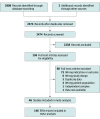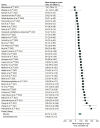Assessment of Changes in Child and Adolescent Screen Time During the COVID-19 Pandemic: A Systematic Review and Meta-analysis
- PMID: 36342702
- PMCID: PMC9641597
- DOI: 10.1001/jamapediatrics.2022.4116
Assessment of Changes in Child and Adolescent Screen Time During the COVID-19 Pandemic: A Systematic Review and Meta-analysis
Abstract
Importance: To limit the spread of COVID-19, numerous restrictions were imposed on youths, including school closures, isolation requirements, social distancing, and cancelation of extracurricular activities, which independently or collectively may have shifted screen time patterns.
Objective: To estimate changes in the duration, content, and context of screen time of children and adolescents by comparing estimates taken before the pandemic with those taken during the pandemic and to determine when and for whom screen time has increased the most.
Data sources: Electronic databases were searched between January 1, 2020, and March 5, 2022, including MEDLINE, Embase, PsycINFO, and the Cochrane Central Register of Controlled Trials. A total of 2474 nonduplicate records were retrieved.
Study selection: Study inclusion criteria were reported changes in the duration (minutes per day) of screen time before and during the pandemic; children, adolescents, and young adults (≤18 years); longitudinal or retrospective estimates; peer reviewed; and published in English.
Data extraction and synthesis: A total of 136 articles underwent full-text review. Data were analyzed from April 6, 2022, to May 5, 2022, with a random-effects meta-analysis.
Main outcomes and measures: Change in daily screen time comparing estimates taken before vs during the COVID-19 pandemic.
Results: The meta-analysis included 46 studies (146 effect sizes; 29 017 children; 57% male; and mean [SD] age, 9 [4.1] years) revealed that, from a baseline prepandemic value of 162 min/d (2.7 h/d), during the pandemic there was an increase in screen time of 84 min/d (1.4 h/d), representing a 52% increase. Increases were particularly marked for individuals aged 12 to 18 years (k [number of sample estimates] = 26; 110 min/d) and for device type (handheld devices [k = 20; 44 min/d] and personal computers [k = 13; 46 min/d]). Moderator analyses showed that increases were possibly larger in retrospective (k = 36; 116 min/d) vs longitudinal (k = 51; 65 min/d) studies. Mean increases were observed in samples examining both recreational screen time alone (k = 54; 84 min/d) and total daily screen time combining recreational and educational use (k = 33; 68 min/d).
Conclusions and relevance: The COVID-19 pandemic has led to considerable disruptions in the lives and routines of children, adolescents, and families, which is likely associated with increased levels of screen time. Findings suggest that when interacting with children and caregivers, practitioners should place a critical focus on promoting healthy device habits, which can include moderating daily use; choosing age-appropriate programs; promoting device-free time, sleep, and physical activity; and encouraging children to use screens as a creative outlet or a means to meaningfully connect with others.
Conflict of interest statement
Figures


References
Publication types
MeSH terms
LinkOut - more resources
Full Text Sources
Medical
Miscellaneous

